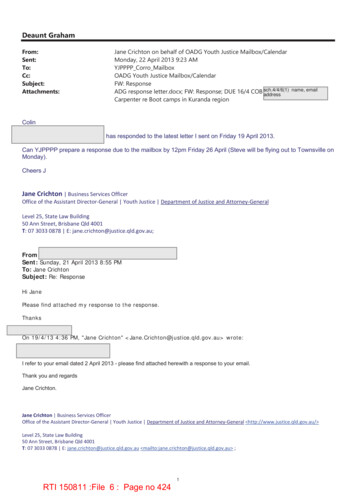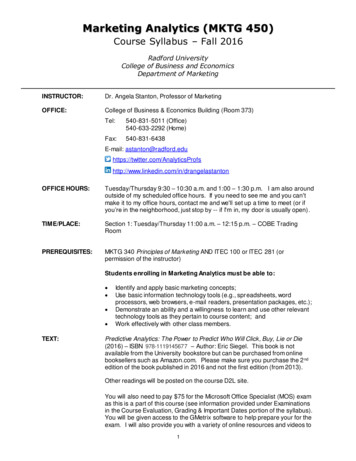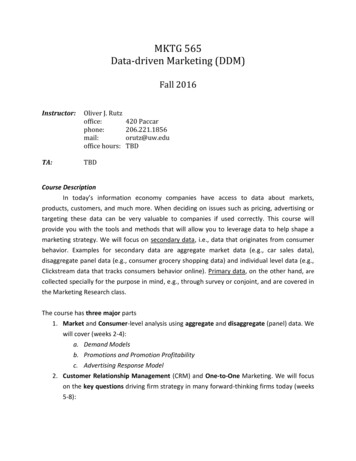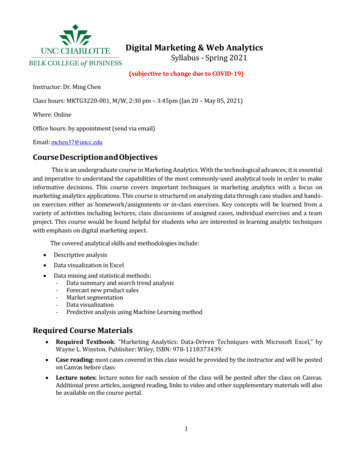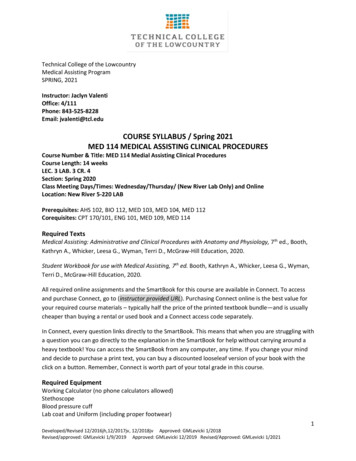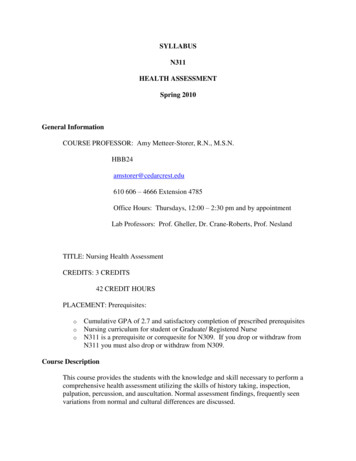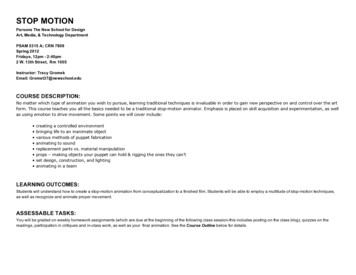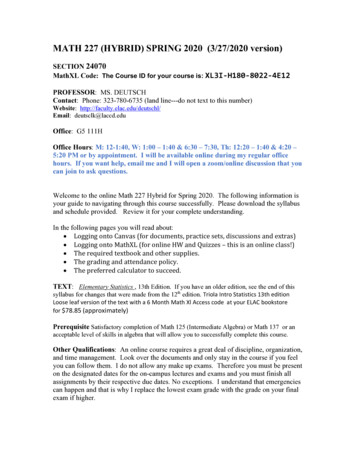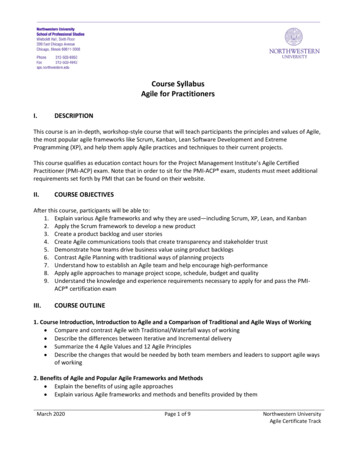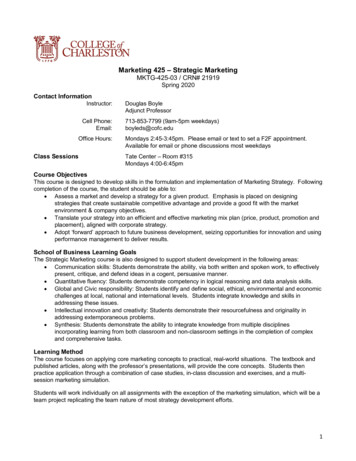
Transcription
Marketing 425 – Strategic MarketingMKTG-425-03 / CRN# 21919Spring 2020Contact InformationInstructor:Cell Phone:Email:Office Hours:Class SessionsDouglas BoyleAdjunct Professor713-853-7799 (9am-5pm weekdays)boyleds@cofc.eduMondays 2:45-3:45pm. Please email or text to set a F2F appointment.Available for email or phone discussions most weekdaysTate Center – Room #315Mondays 4:00-6:45pmCourse ObjectivesThis course is designed to develop skills in the formulation and implementation of Marketing Strategy. Followingcompletion of the course, the student should be able to: Assess a market and develop a strategy for a given product. Emphasis is placed on designingstrategies that create sustainable competitive advantage and provide a good fit with the marketenvironment & company objectives. Translate your strategy into an efficient and effective marketing mix plan (price, product, promotion andplacement), aligned with corporate strategy. Adopt ‘forward’ approach to future business development, seizing opportunities for innovation and usingperformance management to deliver results.School of Business Learning GoalsThe Strategic Marketing course is also designed to support student development in the following areas: Communication skills: Students demonstrate the ability, via both written and spoken work, to effectivelypresent, critique, and defend ideas in a cogent, persuasive manner. Quantitative fluency: Students demonstrate competency in logical reasoning and data analysis skills. Global and Civic responsibility: Students identify and define social, ethical, environmental and economicchallenges at local, national and international levels. Students integrate knowledge and skills inaddressing these issues. Intellectual innovation and creativity: Students demonstrate their resourcefulness and originality inaddressing extemporaneous problems. Synthesis: Students demonstrate the ability to integrate knowledge from multiple disciplinesincorporating learning from both classroom and non-classroom settings in the completion of complexand comprehensive tasks.Learning MethodThe course focuses on applying core marketing concepts to practical, real-world situations. The textbook andpublished articles, along with the professor’s presentations, will provide the core concepts. Students thenpractice application through a combination of case studies, in-class discussion and exercises, and a multisession marketing simulation.Students will work individually on all assignments with the exception of the marketing simulation, which will be ateam project replicating the team nature of most strategy development efforts.1
Course MaterialsThe 3 MKTG 425 sections use similar materials for much of the reading and simulation exercise. These include: Textbook: Walker & Mullins’ “Marketing Strategy: A Decision-Focused Approach” (8th edition) providesan excellent framework for understanding how marketing strategy varies according to the environmentscenarios. The text is available at no cost at the following site:https://www.academia.edu/16221233/Marketing Strategy A Decision-Focused Approach Eight Edition. Youmay need to register to enable download but Academia is a reputable site. Course Pack: Four cases have been selected for case reports; each one addresses a different topic(Market Analysis, Positioning, Mature Markets and Portfolio Management). Additionally, a ‘teachingcase’ has been selected to provide example for Customer Analysis. Harvard Business Press articlesalso supplement the Walker/Mullins text, which does not cover some sections effectively. The HBPmaterials are listed on page 11 of the Syllabus and are available at the following site:https://hbsp.harvard.edu/import/675162 Presentations: Copies of the Professor’s presentation slides will be available at the course site on Oaksapproximately 1 week before each class session.Simulation: The “Strategic Marketing Simulation: Bikes” from Marketplace Live will be used throughoutthe last half of the course. Each student will need to register for the simulation using the course andteam identification information provided in-class.Course OverviewThe course focuses on applying core marketing concepts to practical, real-world situations. There are 4 majorsections to the course and key concepts will be reinforced in the 2nd half through a marketing simulation.Section1. Corporate &Brand Strategy2. Financial &Planning Tools3. EnvironmentalScenarios4. ManagementOpportunities/RisksSession #Topics1Course Overview. Market Analysis2Customer Analysis. Marketing Strategy Framework3Targeting & Positioning4Marketing Financial Analysis5Marketing Planning6New Market Entry7Growth Markets8Mature & Declining Markets9Digital Disruption10Pricing & Portfolio Management11Marketing Ethics12Implementing & Controlling Plans13Course Summary & Wrap-upBikesSimulationGradingCourse grading will be based on the following criteria and weighting:Grade ComponentClass ParticipationCase Reports (4 x 8%)Examinations Financial Analysis & Planning exercises (2 x 4%) Mid-Term Exam Final Exam ETS Major Field TestBikes Simulation (Team) Marketing Plan (Quarters 5-8) Performance (Quarters 5-8) Hand-off memo & presentation% Weighting10%32%8%5%10%10%}33%15%5%5%}25%2
Case reports and Examinations will be individual exercises (as is the class participation assessment); only theBike Simulation will be a team assessment exercise. Guidance on each component follows: Case ReportsCase study provides an excellent opportunity to apply course learning to a real-world situation. Eachcase has been selected to highlight one particular aspect of Marketing Strategy development orimplementation. The learning sequence will be to review the relevant theory in class (e.g. portfoliomanagement), follow it with a case study and report focusing on an aspect of the theory (e.g. lineextensions), and then discuss the case in the following class session.The schedule of case reports, questions and due dates is listed below.TopicCaseQuestions for ReportDue Date(400PM @ Oaks)Corporate StrategyLidl: A German Grocer in “Using Porter’s 5 1 Forces model, assess the US Grocerythe USindustry and implications for Lidl?”Jan 27Brand PositioningSaxonville Sausage“Which positioning do you recommend for Vivio and why?”(Please address brand name, positioning statement andany product, package, communications or other guidance)Feb 10Mature MarketManagementHunley, Inc“Assess the Titaluk and Walmart opportunities strategically& financially. What should CW3 do?”Mar 23PortfolioManagementWhiskey and Cheddar“Should Caesan launch the Jameson branded product orone using generic whiskey?” (Please address from astrategic and financial standpoint)Apr 6Case reports should be drafted in line with the following guidelines:– Reports should be 2-3 pages in length, exclusive of appendices. They should use a reasonableformat (1.0 line spacing with normal font). Please use appendices to visualize your argument orprovide data tables, applying good judgment on overall length.– Case reports must be uploaded to the course Dropbox on Oaks by the start of the class session(4:00pm ET) on the date outlined above. As the case will be discussed in the class session, nolate submissions will be accepted.– Cases are meant to be assessed and actioned with only the information given in the case.Please do not do any additional research on the company as part of your preparation.– All Case reports are individual assignments. Recommendations in your reports should be basedon individual analysis and assessment only. ExaminationsThere are 2 quantitative exercises and a Mid-Term & Final Examination focused on MKTG 425 content:– Marketing Financial Analysis Exercise (4% of course grade): Held in-class during Session 5(Feb 17). Assesses understanding of financial analysis and marketing return metrics through 4exercises.– Marketing Planning Exercise (4% of course grade): Homework assignment due to Oaks prior toSession 6 (Feb 24). Assesses ability to build a financial forecast based on integrating selectedinitiatives.– Mid-Term Examination (5% of course grade): Held in-class during Session 7 (Mar 2). Assessesunderstanding of material through Session 6 using multiple choice & short-answer questions.– Final Examination (10% of course grade): Held during Finals week – the time slot for ourcourse is Monday, April 27th, starting at 7:30pm. Session 13 (Apr 22). Assesses understandingof entire course material using multiple choice, short-answer & calculation format questions.Together, these examinations represent 23% of course grade.In addition to the MKTG 425 exams, the ETS Major Field Test is required of all School of BusinessSeniors and must account for 10% of the capstone course grade. The ETS Major Field Test is a twohour multiple-choice test administered to graduating students assessing mastery of general businessconcepts, principles, and knowledge. The test also evaluates students’ abilities to analyze and solveproblems, understand relationships, and interpret material. The content area includes: accounting,economics, management, quantitative business analysis, information systems, finance, marketing, legaland social environment, and international issues.3
The ETS test is also an important evaluation for the School of Business which uses the learning data toimprove courses and programs, helping to make students more competitive in today’s job market. Theaggregate data, analysis of the data, recommendations for program improvement and follow-upassessment are reported to our accrediting agencies. We have longitudinal comparative data from2006 to the present.Direct benefits of the ETS Major Field Test for the student includes the opportunity to add highpercentile scores to your resume or application letters, and the indirect benefit of enhancing the value ofyour School of Business degree (as the School’s reputation grows). Per School policy, seniors in thecapstone courses are required to take the ETS Major Field Test. Strategic Marketing Simulation: BikesThe Bikes simulation gives the student experience in marketing strategy formulation, marketing mixmanagement and responding to changing competitive dynamics over a two-year timeframe. Thesimulation will be conducted on a team basis, allowing some sharing of the analysis and planning work,and replicating how management teams operate. Students will form their own teams with a target sizeof 3 or 4 individuals.Additional information about the simulation and how to gain access will be shared in class session andon Oaks. You will be required to use the course, game and team identification numbers provided, sodon’t enroll independently. The following link provides an overview if you want to understand thesimulation better in the ategic-marketing-bikes-demoGrading for the simulation is comprised of 3 elements:– Marketing Plan (15% of course grade): The Final Plan is due by 400pm on Thursday, March 12thand should be submitted to the course Dropbox. From a simulation standpoint, the Plan issubmitted following receipt of 4th Quarter results, and covers the coming year (Q5-Q8).The Plan should be 4-5 pages in length ( appendices) and follow the format that will be reviewedin class. As the Plan is the single largest component to the overall course grade, I will review DraftPlans submitted before 400pm on Thursday, March 5th and provide feedback to the teams forimprovement by the class meeting on March 9th.– Performance (5% of course grade): Performance is assessed over the Q5-8 timeframe using thesimulation’s balanced scorecard that includes financial performance, market share, customersatisfaction, brand quality perception and return on investment.– “Hand-off” memo & presentation (5% of course grade): Congratulations! After two years asStrategy Manager for Bikes, it’s time to move your next assignment. The “Hand-off” memo is a 3page memo to written to your successor addressing three questions:1. What was your key learning regarding the Strategy outlined in your Plan?2. How should the Strategy evolve going forward? What are the key success factors?3. What are your recommended customer & financial goals for the coming year (Q9-12)?Additionally, each team will give a 5-7 minute presentation during the final class session (April 20th)addressing Questions #1-2 above on two slides. Templates for the presentation and coming yeargoals will be provided in class. Both the Hand-off Memo and Presentation are due by 400pm onMonday, April 20th and should be submitted to the course Dropbox.The schedule for Bikes Simulation decisions and submissions is summarized below:ActionDate due (4pm)ActionDate due (4pm)Q1 decisionWed, Feb 19Q6 decisionThurs, Mar 26Q2 decisionSat, Feb 22Q7 decisionThurs, Apr 2Q3 decisionThurs, Feb 27Q8 decisionThurs, Apr 9Q4 decision & Draft PlanThurs, Mar 5Hand-off Memo & Presentation Mon, Apr 20 (to Dropbox)Q5 decision & Final PlanThurs, Mar 12 (Plan to Dropbox)4
Participation in Class discussionActive involvement in class discussion is critical to your learning and the learning of other students (andworth 10% of overall course grade). Quality of contribution is more important than quantity, but topgrades will be provided for comments such as:– Insightful diagnosis of root cause issues or anticipation of problems– Relating the reading or case study to your own experiences or observations– Proposing potential solutions with rationale and key success factors– Building on other student comments & proposals, either as an enhancement or constructivechallengeEach student’s contributions will be evaluated after each session against the following rating standard:à Non-Participant: Present but did not contribute or missed class. No participation credit forgrading purposes.à Minimal Contributor: Ideas offered were not substantive or not particularly constructive. Littlenew perspective added.à Good Contributor: Active and constructi
The schedule of case reports, questions and due dates is listed below. Topic Case Questions for Report Due Date (400PM @ Oaks) Corporate Strategy Lidl: A German Grocer in the US “Using Porter’s 5 1 Forces model, assess the US Grocery industry and implications for Lidl?” Jan 27 Brand Positioning Saxonville Sausage

